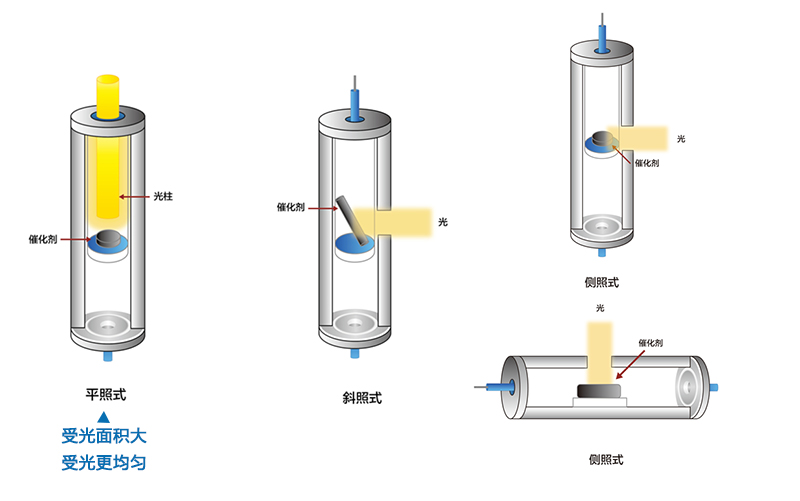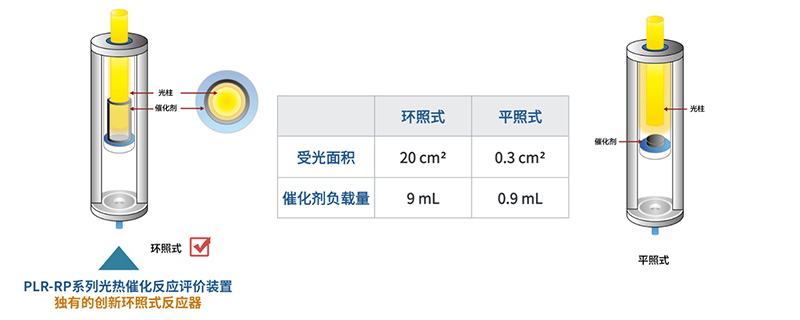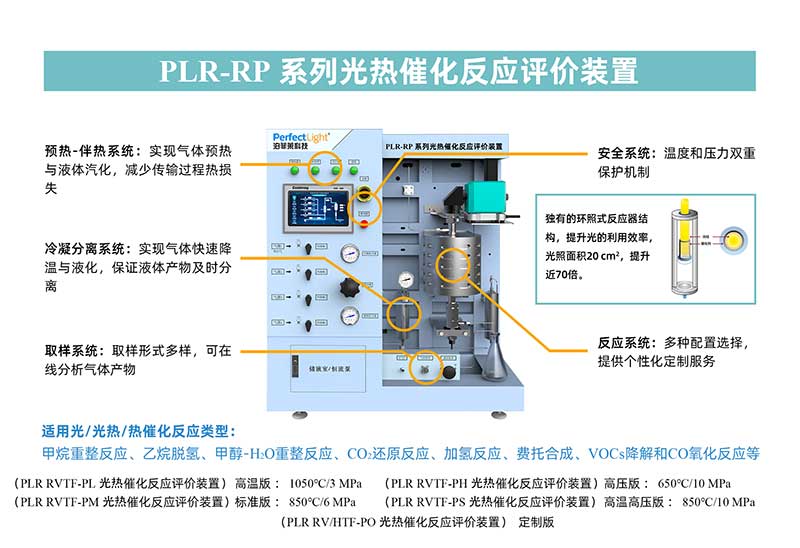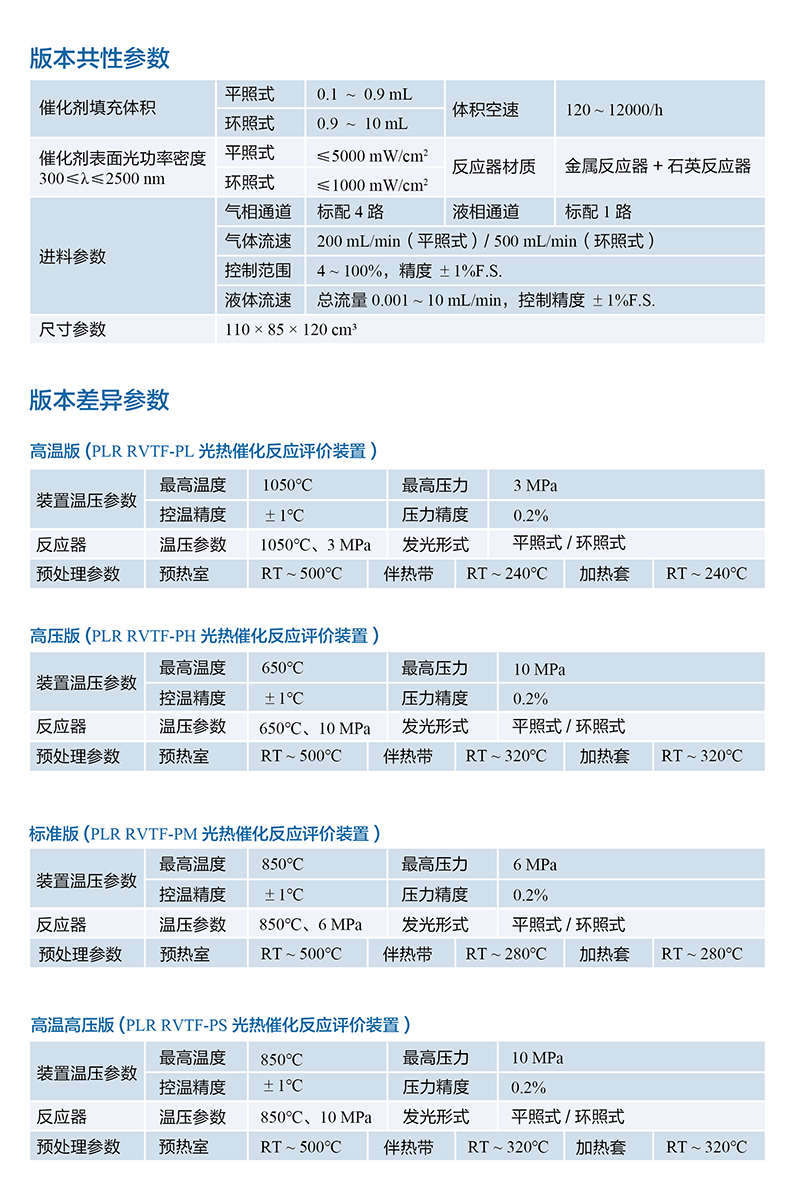Traditional chemical reactions mainly activate reactants through heating to provide the energy needed to overcome thermodynamic barriers and promote the conversion of reactants to products. In a thermal catalysis system, reactant molecules adsorb and activate on the catalyst's surface, altering the chemical reaction pathway, thus lowering the activation energy and making the reaction easier. In contrast, photocatalysis utilizes the energy of photons to catalyze reactions. The reaction mechanism and pathway in photocatalysis are entirely different from thermal catalysis, and the reaction conditions are mild and easy to control.
In recent years, as catalysis research has delved deeper, scientists have found that photothermal catalysis can not only improve the efficiency of catalytic reactions but can also convert low-density solar energy into high-density chemical energy. The effective combination of these two can exceed the effects achievable by thermal catalysis or photocatalysis alone. Moreover, by adjusting the reaction conditions, it is possible to control the activity and selectivity of the reactions. This has invaluable potential in the fields of energy and the environment and is a focal point of current research on new catalytic technologies.
Perfectlight Technology introduces the PLR-RP series photothermal catalytic reaction evaluation apparatus, providing a platform for the systematic study of photothermal catalytic reactions. It utilizes an innovative quartz column light-guiding method and reactor design to enhance the radiation efficiency of the light source and the light-absorbing surface area of the catalyst, meeting the requirements of gas-solid phase reactions under photothermal catalysis.
▲ Highly Applicable ● Moderately Applicable ○ Applicable
▲ Catalytic material atmosphere sintering
▲ Activity evaluation of catalytic materials
▲ Gas-solid phase photothermal catalytic reactions
▲ Photothermal degradation of gaseous pollutants
▲ Methane reforming for hydrogen production
▲ Carbon dioxide reduction
▲ Methane/carbon dioxide reforming
▲ Methane coupling
▲ Ethane dehydrogenation
▲ Fischer-Tropsch synthesis
▲ Photothermal catalytic degradation of VOCs
▲ Study of the conversion mechanisms of atmospheric NOx and SO2
Advanced illumination system to enhance light utilization
The PLR-RP series photothermal catalytic reaction evaluation apparatus uses quartz columns combined with the system, allowing light to reach the core furnace directly, reducing losses during light transmission. The flexible design of the quartz column and the quartz reactor can fully complement the catalyst loading method, ensuring that every beam of light can efficiently irradiate the catalyst's surface from the outside, significantly improving light utilization in the photothermal system.
Compared to oblique and lateral illumination, the flat illumination mode exposes a larger surface of the catalyst to light, resulting in better uniformity of light absorption by the catalyst. It can also achieve a reaction mode in which reactants penetrate the catalyst. This maximizes the absorption efficiency of the catalyst for light and the adsorption efficiency of substrates, optimizing photothermal systems.

To further enhance photothermal catalytic conversion efficiency, the PLR-RP series photothermal catalytic reaction evaluation apparatus is equipped with an innovative circumferential illumination reactor. This design surrounds the catalyst with light sources, effectively increasing the catalyst's light-receiving surface area from the 0.3 cm2 area of flat illumination to about 20 cm2. This ensures that the catalyst is in full contact with light. Simultaneously, while ensuring effective light penetration, the catalyst loading volume increases from 0.9 mL to 9 mL. This innovation not only significantly improves light utilization but also increases the adsorption and conversion of substrates, providing new ideas for industrial photothermal reaction system implementation.
The PLR-RP series photothermal catalytic reaction evaluation apparatus adopts a convenient light source positioning device design to improve light source positioning efficiency. The multi-adjustable hole positions on the support plate make it easy to adjust the position of the light source from front to back and left to right. Paired with Perfectlight Technology's independently developed light source system, it ensures the stability of the light source in every experiment, guaranteeing the accuracy of each experimental result.

Precisely designed thermal control structure to improve thermal energy utilization
The PLR-RP series photothermal catalytic reaction evaluation apparatus features a four-level temperature management structure. This includes the gas preheating system, pipeline trace heating structure, reaction system, and condensation separation system. Temperature and pressure are real-time monitored throughout the entire reaction process, including the preheating chamber, pipeline trace heating belt, heating jacket, and reaction chamber, creating an accurate simulation of the chemical reaction process in photothermal catalysis.
Gas preheating system is responsible for preheating the reaction gas to a set temperature. The pipeline trace heating structure reduces heat loss as the gas is transferred from the preheating system to the reaction system. The two-stage system allows the reaction gas to enter the reaction system at a higher temperature to ensure that the reaction gas quickly reaches the set reaction temperature when passing through the core furnace, minimizing the burden on the reaction system and ensuring the accuracy of the reaction temperature. The condensation separation system cools the reaction gas quickly and condenses and separates liquid reactants or products, reducing damage to subsequent components such as back-pressure valves due to high temperature and liquid substances.
Both the preheating system and the reaction system can be set in a 16-stage program temperature rise control mode, allowing determination of the initial reaction temperature in one experiment and study of reaction rates and conversion rates at different reaction temperatures. This ensures that every bit of thermal energy is utilized effectively.
In order for liquid reactants to participate in the reaction, the PLR-RP series photothermal catalytic reaction evaluation apparatus also designs four functional modules: liquid delivery - vaporization - pipeline trace heating - condensation separation.
The liquid delivery system ensures a constant volume of liquid entering the preheating chamber. The preheating chamber uses a special vaporizer structure to effectively prevent problems such as the vaporizer's large volume, unstable gas output after vaporization, and the inability to vaporize in real-time, ensuring a stable output of the liquid-vapor mixture. The pipeline trace heating structure effectively prevents liquid condensation before entering the reaction chamber. The condensation separation system after the reaction can rapidly cool the unreacted liquid feedstock and the liquid reaction products to collect them in the separator for subsequent analysis of the reaction process.

Flexible and diverse configurations, experience customized services
The PLR-RP series photothermal catalytic reaction evaluation apparatus offers different configurations from the reaction chamber, light source mode, to reaction temperature and pressure conditions, aiming to meet the requirements of photothermal catalytic reactions with different reaction rates and conditions. The reaction chamber can be selected in two types: vertical furnace and horizontal furnace. The light source mode includes top-illumination reactor and circumferential-illumination reactor. Depending on different reaction temperature and pressure conditions, the device comes in various specifications: high-temperature version with a maximum furnace temperature of 1050°C and a maximum gauge pressure of 3 MPa; standard version with 850°C and 6 MPa; high-pressure version with 650°C and 10 MPa; customized version with 650, 850, and 1050 options, and 3, 6, 10 options.
If the above configurations do not meet the reaction requirements, Perfectlight Technology also offers customized services to create the most suitable photothermal catalytic reaction apparatus.
Secondary alarm functions for experiment safety
The PLR-RP series photothermal catalytic reaction evaluation apparatus features a dual protection mechanism for temperature and pressure in both hardware and software control, ensuring safer and more reliable photothermal reactions. In case of safety issues like leakage, functional loss of control, or overpressure during experiments, the system automatically initiates a chain of protective measures.
Temperature has a two-level alarm system. An audible and visual alarm goes off when the temperature exceeds the first set value, and heating is automatically stopped when it exceeds the second set value. If pressure surpasses the set value, an audible and visual alarm sounds and material feed is automatically stopped.
Diverse sampling methods for online gas product analysis
The PLR-RP series photothermal catalytic reaction evaluation apparatus includes a separate gas phase gas distribution port for gas calibration. The device offers various sampling methods such as gas online feeding/sampling, intermittent gas sampling, and liquid sampling, which can be paired with upstream pressure reducing devices and downstream detection devices (mass spectrometers, gas chromatographs, etc.). This allows online detection of the reaction process and complete detection of reaction products.
Performance Parameters for Tubular Gas-Solid Phase Reaction Evaluation System

Note: Specific device material flow rates and catalyst loading amounts are subject to the compatibility of the specific reactor. Refer to the detailed reactor specification and selection table for details.